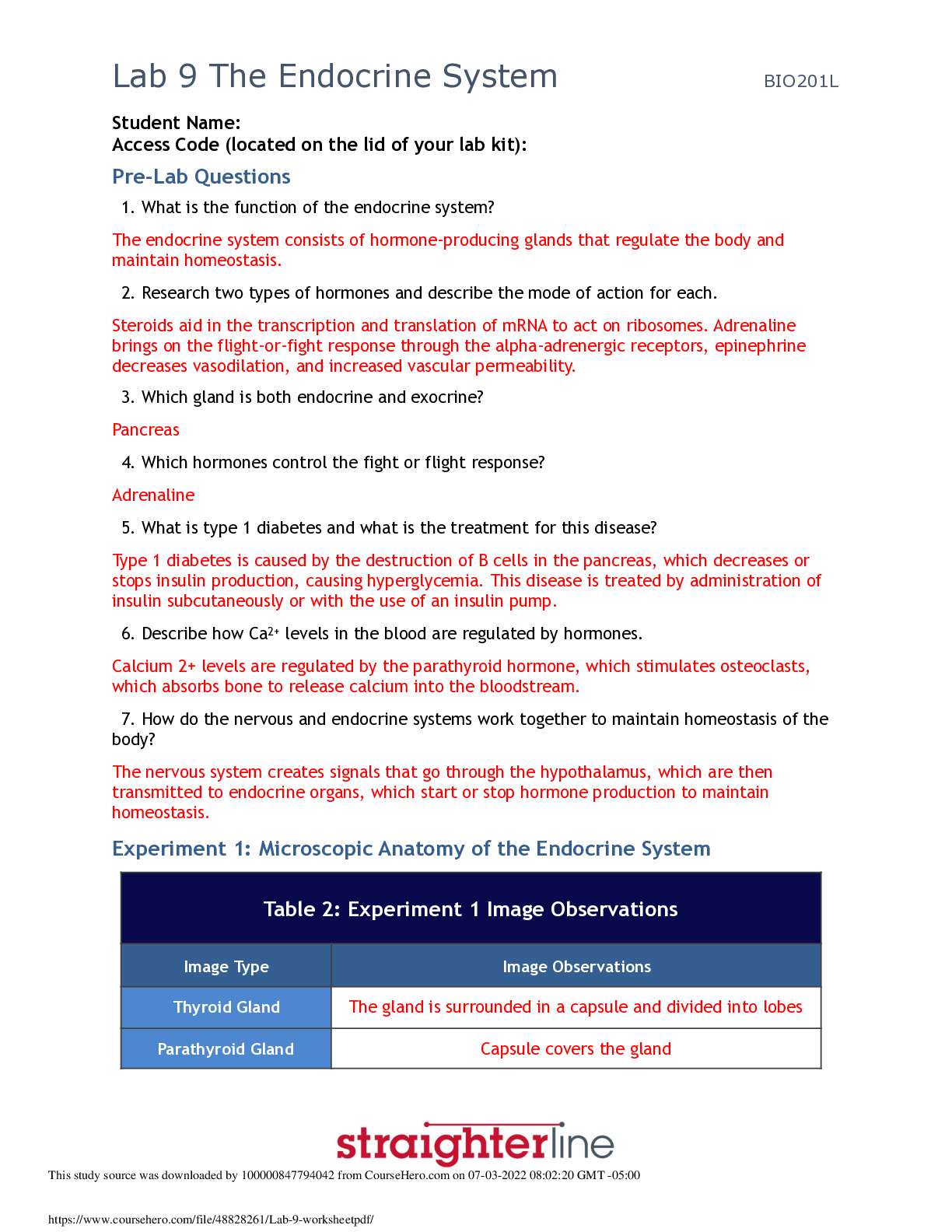Nutrition > Lab Report > PORTAGE LEARNING||LAB NUTRITION REPORT_ LATEST 2022 (All)
PORTAGE LEARNING||LAB NUTRITION REPORT_ LATEST 2022
Document Content and Description Below
Digestive System Lab 5 The primary function of the digestive system is to take in nutrients and break them down into useable forms that the body can process. The basic process of this, is of cour... se, to ingest the food, we process it, we absorb the nutrients, and then we eliminate the residue. More specifically there are, 5 stages of digestion. You have ingestion of course, which is taking in the food. We have digestion, which is made up of two stages---we have a physical or mechanical digestion process, which physically and mechanically breaks down the food into smaller components---- and then we have a chemical digestion process, that will use enzymes and hormones to break down those products even further, into the useable components that the body can absorb, that brings us into our third stage of digestion, in which is absorption. Once the products are broken down into those small components, the body can then absorb them into the blood stream where they are then processed and delivered into the other organs, muscles, any of the parts of the body that needs those specific nutrients. The fourth stage is compaction, so the body will absorb or take out the water from the digestive system and return it to the body, allowing the waste product to be formed into a more solid component. Which will then lead into the fifth stage of digestion, which is defecation or elimination of those solid waste products. The general anatomy of the digestive system starts at the mouth, so it’s open to the environment at the beginning entry point of the digestive tract, and it ends at the anus, so it is also opened to environment at the exit point. If we go through the pathway of the digestive system---again, we start at the mouth---and we go through a region called the pharynx. Which is commonly referred to as the throat. From the pharynx, the food residue passes into the Esophagus, which is the muscular tube that carries the food to the stomach. The stomach then leads to the small intestine. The small intestine will lead into the large intestine, and then that would carry the solid waste products (the food) out of the body through the anus. ---So, if we look at some basic components (2:47) of the digestive system, of course we start at the mouth, and some of the parts we cannot see in this model, are the pharynx and the esophagus. “If we take out the lungs, we can uncover parts of the digestive system. We’re going to go from the pharynx into the esophagus, and lead into the muscular sac called the stomach. Which is simply a organ for food storage. From the stomach we then lead into the small intestine, and then from the small intestine we lead into the large intestine, sometimes just referred to as the colon. And then from the colon if we take out our model pieces, it will lead into the rectum, which leads into the anus, and that will allow for defecation of the food wastes.”---So those organs cover the main parts of the digestive system, called the Digestive tract. Key Terms: Digestive Tract Pharynx • Esophagus • Colon • Rectum • Anus • There are accessory organs and structures to the digestive system that are as equally important to those primary structures. When we start in the mouth, we are looking at structures called the teeth, tongue and salivary glands that realize enzymes that help with digestion. When we look more internally we are looking at three specific organs or glands called the liver, the pancreas and the gallbladder. And we’re going to go through all of these structures as we dissect the pig, and we’ll go through more of their functions as we look at them on the fetal pig. [Show More]
Last updated: 2 years ago
Preview 1 out of 14 pages

Buy this document to get the full access instantly
Instant Download Access after purchase
Buy NowInstant download
We Accept:

Reviews( 0 )
$7.00
Can't find what you want? Try our AI powered Search
Document information
Connected school, study & course
About the document
Uploaded On
Jul 05, 2022
Number of pages
14
Written in
Additional information
This document has been written for:
Uploaded
Jul 05, 2022
Downloads
0
Views
66



